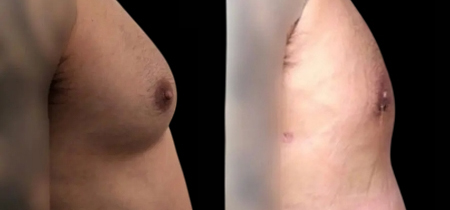Microneedling Recovery & Aftercare with Dr Fasano Congratulations on taking the step toward healthier, rejuvenated skin! Following your microneedling treatment, proper aftercare is essential to...
Introduction
What Is Gynecomastia?
Gynecomastia is a common condition where men develop excess breast tissue, leading to a more feminine chest appearance. It may occur at any age but is particularly common during puberty and later in life due to hormonal changes. This condition is typically benign, but it can be physically uncomfortable and emotionally distressing. Men experiencing gynecomastia may feel self-conscious about their appearance, leading to avoidance of situations like swimming or wearing tight clothing.
Why It Matters
The impact of gynecomastia extends beyond physical appearance. Many sufferers report significant psychological effects, including anxiety, embarrassment, and social withdrawal. The condition can interfere with daily life and relationships, creating a profound lack of confidence. Even if it does not cause physical pain, the emotional and mental toll should not be underestimated, making treatment essential for holistic wellbeing.
Growing Demand in London
London has seen a surge in demand for male cosmetic procedures, with gynecomastia surgery leading the trend. This rise is fuelled by increasing awareness, greater acceptance of male aesthetic treatments, and the availability of top-tier medical professionals. With its concentration of elite private clinics and specialists, London has become a go-to city for men looking to regain confidence through chest reduction surgery.
Causes and Symptoms
Gynecomastia results primarily from a hormonal imbalance between testosterone and oestrogen. Testosterone typically suppresses breast tissue growth, while oestrogen promotes it. When this balance is disrupted, often during puberty, ageing, or due to medical conditions, it can lead to breast enlargement.
Common medical and lifestyle causes include:
- Certain prescription medications (e.g., anti-androgens, antidepressants)
- Anabolic steroids and recreational drugs (e.g., cannabis, alcohol)
- Obesity, which increases oestrogen levels
- Liver or kidney disorders
- Hyperthyroidism
Symptoms include a noticeable lump under the nipple, swelling, tenderness, and sometimes pain. It’s often symmetrical but can also occur in just one breast. Although rare, it’s essential to differentiate gynecomastia from male breast cancer, making professional diagnosis crucial.
Types of Gynecomastia
Gynecomastia is classified into:
- True gynecomastia, where excess glandular breast tissue is present
- Pseudogynecomastia, caused by fat accumulation without glandular growth
A qualified surgeon will perform a physical examination and may request imaging tests to determine the type. Accurate diagnosis helps in selecting the most appropriate treatment strategy, as pseudogynecomastia may respond better to weight loss, while true gynecomastia requires surgical intervention.
Surgical Options for Gynecomastia
The goal of gynecomastia surgery is to remove excess breast tissue and restore a flatter, more masculine chest contour. Procedures typically fall into three categories:
- Liposuction: Best suited for pseudogynecomastia, this involves small incisions and suction of fat deposits. It’s minimally invasive with quicker recovery times.
- Excision: Used for true gynecomastia, excision removes dense glandular tissue. It may involve incisions around the areola or chest to ensure even contouring.
- Combination surgery: Many patients benefit from both liposuction and excision, offering the most comprehensive results.
The procedure is often performed under general anaesthesia and lasts between 1-2 hours. Surgeons tailor the approach based on the severity, skin elasticity, and the patient’s goals.
Who Can Have Gynecomastia Surgery?
Gynecomastia surgery is ideal for men who:
- Are physically healthy with no serious medical conditions
- Have stable weight and are close to their ideal body shape
- Do not have underlying conditions causing breast enlargement
- Are emotionally stable and have realistic expectations
Patients should also be non-smokers or willing to stop smoking before and after the procedure, as it affects healing.
Potential Risks
As with all surgeries, gynecomastia procedures carry certain risks. These may include:
- Bleeding or haematoma
- Infection at the incision site
- Scarring or uneven chest contour
- Asymmetry between the breasts
- Temporary or permanent loss of nipple sensation
Choosing a skilled, certified surgeon and adhering strictly to pre- and post-operative guidelines greatly reduces the likelihood of complications.
Why Choose London?
London boasts a concentration of top-rated cosmetic surgeons with international credentials. Many surgeons are affiliated with prestigious organisations like BAAPS (British Association of Aesthetic Plastic Surgeons) and BAPRAS (British Association of Plastic, Reconstructive and Aesthetic Surgeons).
Benefits of choosing London include:
- Access to cutting-edge surgical facilities
- Personalised care in private clinics
- Surgeons with specialised experience in male chest contouring
Patients can also access a range of pre- and post-operative services, including follow-ups, scar management therapies, and psychological support if needed.
During consultations, it’s advisable to:
- Request before and after photos
- Ask about revision rates
- Understand the expected outcome and healing timeline
Why You Should Contact Dr Fasano in London
Dr Fasano is a leading consultant cosmetic surgeon in London, known for his patient-centred approach and excellent outcomes in male chest surgery. His expertise in gynecomastia treatment is supported by years of experience, advanced training, and a reputation for outstanding care.
Choosing Dr Fasano means working with a surgeon who understands the sensitive nature of gynecomastia and approaches each case with discretion, empathy, and precision. His clinic offers a calm and professional environment, ensuring you feel at ease from the first consultation to your final check-up.
Here’s why Dr Fasano stands out:
- Personalised treatment plans tailored to your anatomy and goals
- Transparent and honest communication
- An extensive gallery of successful before-and-after results
- State-of-the-art surgical techniques for minimal scarring and optimal results
- Exceptional aftercare and support throughout your recovery
Patients consistently praise Dr Fasano for transforming not just their appearance, but their confidence and lifestyle. If you’re considering gynecomastia surgery in London, contacting Dr Fasano is a confident step towards reclaiming your self-image and quality of life.
What to Expect
Before Surgery
Preparation begins with a comprehensive consultation. The surgeon will assess your chest, review medical history, and discuss your goals. You may need blood tests or imaging to confirm the diagnosis. Patients are advised to stop smoking, avoid alcohol, and discontinue medications that thin the blood.
On the Day
The procedure usually takes place in a day-surgery setting under general anaesthesia. The operation lasts between 60 and 120 minutes. Once complete, patients are fitted with a compression garment and monitored before being discharged the same day.
Recovery
Post-surgical recovery includes:
- Week 1: Bruising, swelling, and mild pain; rest is essential.
- Weeks 2-3: Most daily activities can resume; light movement helps circulation.
- After Week 4: Full activities, including gym workouts, can generally be resumed.
Wearing a compression vest for 4-6 weeks aids in reducing swelling and shaping the chest. Patients should attend follow-ups to monitor healing and receive advice on scar care, such as silicone gel applications or laser therapy.
Results of Gynecomastia Surgery and Lifestyle Benefits
Most patients see noticeable improvement within a few weeks, but optimal results are typically visible at the 3-6 month mark. The physical transformation is often accompanied by dramatic improvements in self-confidence and body image.
Benefits include:
- Improved posture and body alignment
- Freedom to wear fitted clothes or go shirtless
- Greater participation in social and fitness activities
Long-term results are stable, particularly when patients maintain a healthy lifestyle and weight. Routine exercise and balanced hormones help preserve the outcome.
Non-Surgical Alternatives
Alternatives include:
- Hormone therapy: Used when hormonal imbalance is the root cause, under endocrinologist supervision.
- Diet and exercise: Effective for pseudogynecomastia, not true glandular cases.
- CoolSculpting or ultrasound treatments: May slightly reduce fat but are not effective for glandular tissue.
These options can benefit certain individuals but often yield limited results. Surgery remains the most definitive solution.
FAQs on Gynecomastia Surgery
Can gynecomastia come back?
Recurrence is rare, especially if underlying causes are addressed. However, weight gain or new hormonal imbalances can trigger reappearance.
Will I lose sensation in my chest?
Temporary numbness is common, but most patients regain full or near-full sensation within months.
Can I work out after surgery?
Light cardio is allowed after 2-3 weeks. Avoid chest-focused exercises for at least 6 weeks to ensure proper healing.
How do I choose a clinic?
Focus on GMC-registered surgeons, read patient reviews, view real results, and book consultations to compare approaches.
Recap
Gynecomastia surgery offers a lasting solution for men troubled by excess chest tissue. With London’s elite medical resources and expert practitioners, men have access to world-class care. If you’re considering the procedure, start with a consultation to explore your options, understand the process, and take control of your body and confidence.
Don’t let gynecomastia dictate your life—take the first step today.







